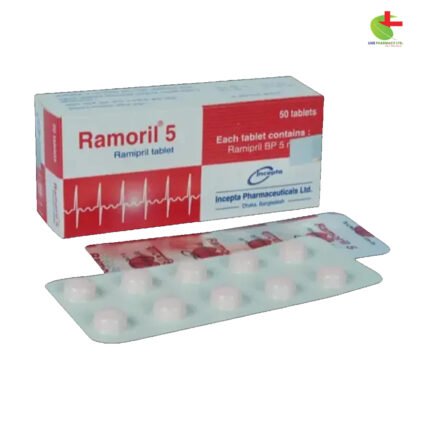Ramoril 10
120.00৳ Strip
- Ramoril is an ACE inhibitor used to treat high blood pressure, heart failure, and reduce the risk of major cardiovascular events such as heart attack and stroke.
- It works by relaxing blood vessels, improving blood flow, and reducing strain on the heart.
- Ramipril is also prescribed for patients with kidney disease and those recovering from a heart attack.
- Always follow a healthcare provider’s guidance for proper dosage and use.
 Brand
Brand
|
Incepta Pharmaceuticals Ltd |
|---|---|
 Generics
Generics
|
Ramipril |
 Type
Type
|
Tablet |
Indications
Ramoril Tablets are prescribed for the management of:
- Hypertension: To effectively lower blood pressure, either as a monotherapy or in combination with other antihypertensive agents.
- Congestive Heart Failure: Often used alongside diuretics for enhanced efficacy.
- Acute Myocardial Infarction Recovery: For patients showing signs of congestive heart failure within the first few days following a heart attack.
- Kidney Disease: Treatment for both diabetic and non-diabetic patients suffering from glomerular nephropathy.
- Cardiovascular Risk Reduction: Reduces the risk of major cardiovascular events, including myocardial infarction, stroke, and cardiovascular death in patients with coronary artery disease, stroke history, peripheral vascular disease, or diabetes combined with additional cardiovascular risk factors like hypertension, elevated cholesterol, and smoking.
Consult a registered healthcare provider before use.
Pharmacology
Ramipril is an angiotensin-converting enzyme (ACE) inhibitor. After being converted to ramiprilat, it inhibits the conversion of angiotensin I to angiotensin II, a powerful vasoconstrictor. This action lowers blood pressure, reduces aldosterone secretion, and alleviates the workload on the heart. Ramipril is well-tolerated, effective in managing heart failure, and reducing the risk of stroke, heart attack, and cardiovascular mortality. Its long-lasting effects make it suitable for long-term treatment.
Dosage
The dosage of Ramipril should be tailored to each patient’s tolerance and response.
- For Hypertension: Start with 1.25–2.5 mg daily for adults not on diuretics. Adjust doses at intervals of no less than 2 weeks. Maintenance dose: 2.5–20 mg daily.
- For Congestive Heart Failure Post-Myocardial Infarction: Begin treatment 2 days post-MI with 2.5 mg twice daily, increasing to 5 mg twice daily as tolerated.
- For Cardiovascular Risk Prevention: Start with 2.5 mg once daily for the first week, followed by 5 mg daily for the next 3 weeks, and then increase to a 10 mg daily maintenance dose.
- For Renal Impairment: Start with 1.25 mg daily. Adjust depending on clinical response.
Always follow the prescribing physician’s instructions.
Administration
Take Ramipril tablets with a full glass of water. Do not chew or crush the tablets. Food does not significantly impact absorption, so it can be taken with or without meals.
Drug Interactions
- Diuretics: When taken with diuretics, Ramipril may cause severe hypotension or hyperkalemia, especially with potassium-sparing diuretics.
- Lithium: Concomitant use may raise serum lithium levels.
- NSAIDs: May reduce the antihypertensive effect of Ramipril and worsen kidney function.
- Alcohol: May exacerbate low blood pressure and impair the ability to drive or operate machinery.
Contraindications
Ramipril should not be used in the following cases:
- Hypersensitivity to Ramipril or other ACE inhibitors.
- A history of angioedema (severe allergic reaction).
- Concomitant use with sacubitril/valsartan therapy.
- Severe renal artery stenosis or hypotensive conditions.
- Pregnancy and breastfeeding.
- Angiotensin II receptor blockers (AIIRAs) and Aliskiren in patients with renal issues or diabetes.
Side Effects
Ramoril is typically well tolerated, but some users may experience:
- Common: Dizziness, fatigue, headache, and weakness.
- Less frequent: Nausea, vomiting, dry cough, skin rash, hypotension, and anxiety.
- Rare: Angioedema, anaphylactic reactions, hyperkalemia.
Pregnancy & Lactation
Ramipril is contraindicated during pregnancy due to potential risks to the fetus. Discontinue immediately if pregnancy occurs. Not recommended during breastfeeding.
Precautions & Warnings
- Renal Function: Use cautiously in patients with renal impairment, hyperkalemia, or liver disease.
- Elderly: Start with a lower dose of 1.25 mg daily.
- Patients on Diuretics: Discontinue or reduce diuretic doses before starting Ramipril.
Overdose Effects
Overdose may result in severe hypotension, shock, bradycardia, and electrolyte imbalances. Immediate medical attention is required for overdose management, which may include gastric lavage and administration of α1-adrenergic agonists to raise blood pressure.
Therapeutic Class
ACE Inhibitor
Storage Conditions
Store at temperatures below 30°C, away from light and moisture. Keep out of reach of children. Do not use after expiration date. Only use with a prescription from a licensed healthcare provider.













Reviews
There are no reviews yet.